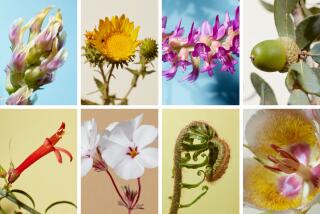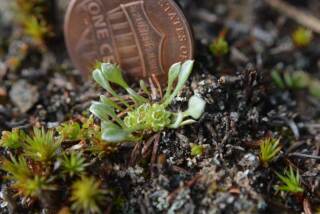Hungers for Knowledge and Adventure : Botanist Goes Far Out for Rare Plant
- Share via
There is a plant growing in the Hawaiian Islands that has leaves 8 feet wide and a strange stem that clings to inaccessible barren cliffs in the world’s rainiest mountains.
Michael Doyle, a Claremont Graduate School botanist, rappelled down ropes dangled on a cable from a hovering helicopter to become the first man to collect specimens of the rarity.
The plant, the Hawaiian gunnera, is believed to be the world’s largest herb and grows only on isolated mountain peaks. The botanical definition of an herb is a flowering plant that does not have a woody stem.
Doyle, 31, who recently returned from his ninth and most successful botanical excursion to Hawaii, said he chose gunnera for his doctoral research because it satisfies his hunger for both knowledge and adventure.
In Rainy Locales
“These plants grow in the most inaccessible places in the world,” Doyle said. “They are on cliffs that are highly eroded from hundreds of inches of rain each year. The weather is so bad you have to wait weeks--sometimes months--for it to break. Being sort of an adventurer, I decided this would be perfect for me.”
Ron Scogin, professor of botany at Claremont Graduate School, said: “It’s safe to say that Michael Doyle has had more adventures in collecting his plants than any other graduate student I’ve met.
“What he has accomplished will add greatly to our understanding of evolution in any isolated system.”
Some of the 40 known species of gunnera grow in Central and South America, but those on the Hawaiian Islands are of interest to botanists because they grow in such isolation and may provide clues to the evolutionary process, Doyle said. He analyzes his samples for their biochemical and genetic differences as part of his research for the doctorate that he expects to earn in about 1 1/2 years.
Plant Fertilizes Itself
One of the unique things about the gunnera is its ability to fertilize itself, and Doyle’s research could lead to the development of other plants that can do the same.
Having heard of the plant from other botanists because of its legendary size, Doyle said that he first saw it in Costa Rica about 8 years ago,
“I essentially fell in love with it,” he said. “It had this strange aspect to it, with a vine-like stem growing on a barren cliff. It was not like anything else and apparently in a family all by itself. I was so fascinated I told myself maybe someday I’ll work on it.”
To do so, he has gone to the highest peaks of most of the islands by helicopter, and then hiked to areas where gunnera grows, often drenched in rain and sometimes slogging in waist-deep mud. On one excursion, he said, he had two assistants and “it took us 2 days to go 1 mile” through dense growth and mud.
“When we finally got to the plants, they were over the cliff and we only got one, after all that work.”
During the past summer, after a long wait for a break in the weather on Kauai’s highest mountain, Doyle had his peak experience. A helicopter pilot who specialized in rescue work maneuvered him on a 150-foot-long cable along cliffs where he was able to obtain specimens of 17 groups of gunnera.
“This was the thrill of my life,” he said. “It was kind of a Peter Pan adventure. If I had been on foot it would have taken me a year to get half that many.”
Doyle described gunnera as “big and spectacular. It is the only flowering plant in the world that has a symbiosis with three different organisms living together--the plant, algae and fungi.”
Because it grows where there is no soil, Doyle said, the algae and fungi that live in the gunnera produce nutrients for their mutual survival.
Doyle said that “with genetic engineering, there is the potential of learning from gunnera something about implanting algae in other plants so they could even make their own fertilizer. That would maybe be one of the greatest steps in agriculture.”
Specimens at College Garden
Some gunnera from Chile is growing at the Bernard Biological Field Station of the Claremont Colleges. The botanical area adjoins Rancho Santa Ana Botanic Garden, a large private institution affiliated with the college. The Claremont Graduate School’s botany program is conducted at the two sites on Foothill Boulevard.
For last summer’s work, Doyle’s climbing equipment was paid for with a $1,200 grant from the Explorer’s Club, an international organization of explorers and scientists.
He found that gunnera--or his quest for it--triggers the imagination of other adventurers who are excited at the prospect of going to places no one has ever been. Thus he has been given free helicopter service and has always had assistants eager to join him.
“We’ve found things that were thought to be extinct. People like me love that,” he said.






